



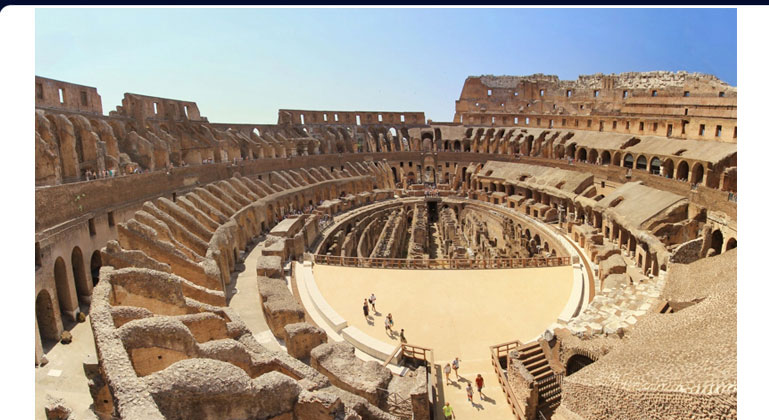
Resonance in Ancient Roman Temples & Amphitheaters
by Alex Putney for Human-Resonance.org
September 8, 2014
Recent breakthroughs in the analysis of ancient building materials warrant a thorough re-examination of technological continuity between the Atlantean Paleo-Sanskrit motherculture and much later Greek and Etruscan phases of advanced civilization that formed the cultural foundation of the Roman Empire.
Clear linguistic continuity has been described in detailed comparisons of the Paleo-Sanskrit language with Etruscan descendant forms, exemplified by lamps bearing hieroglyph texts stating their basic function: ra las , meaning "granting shining".
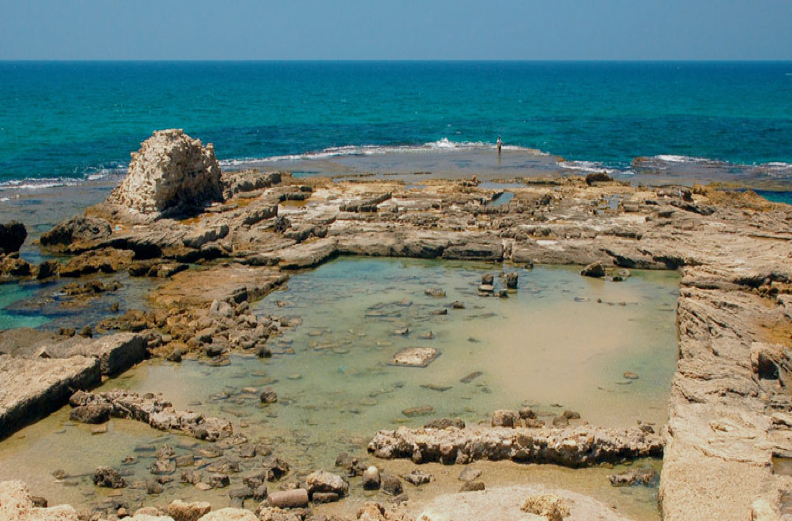
Etruscan blackwares were made with geopolymer ceramics, while surviving examples of Roman harbors constructed in geopolymer concrete display magnificent resistivity to chemical corrosion (above) according to material analyses conducted at Univ. of California at Berkeley:
For underwater structures, lime and volcanic ash were mixed to form mortar, and this mortar and volcanic tuff were packed into wooden forms. The seawater instantly triggered a hot chemical reaction. The lime was hydrated --incorporating water molecules into its structure-- and reacted with the ash to cement the mixture...
First Vitruvius, an engineer for the Emperor Augustus, and later Pliny the Elder recorded that the best maritime concrete was made with ash from volcanic regions of the Gulf of Naples... especially from sites near today's seaside town of Pozzuoli. Ash with similar mineral characteristics, called pozzolan, is found in many parts of the world...
In [modern] concrete made with Portland cement this [binding agent] is a compound of calcium, silicates, and hydrates (C-S-H). Roman concrete produces a significantly different compound, with added aluminum and less silicon. The resulting calcium-aluminum-silicate-hydrate (C-A-S-H) is an exceptionally stable binder...
Their analyses showed that the Roman recipe needed less than 10 percent lime by weight, made at two-thirds or less the temperature required by Portland cement. Lime reacting with aluminum-rich pozzolan ash and seawater formed highly stable C-A-S-H and Al-tobermorite, insuring strength and longevity. Both the materials and the way the Romans used them hold lessons for the future.
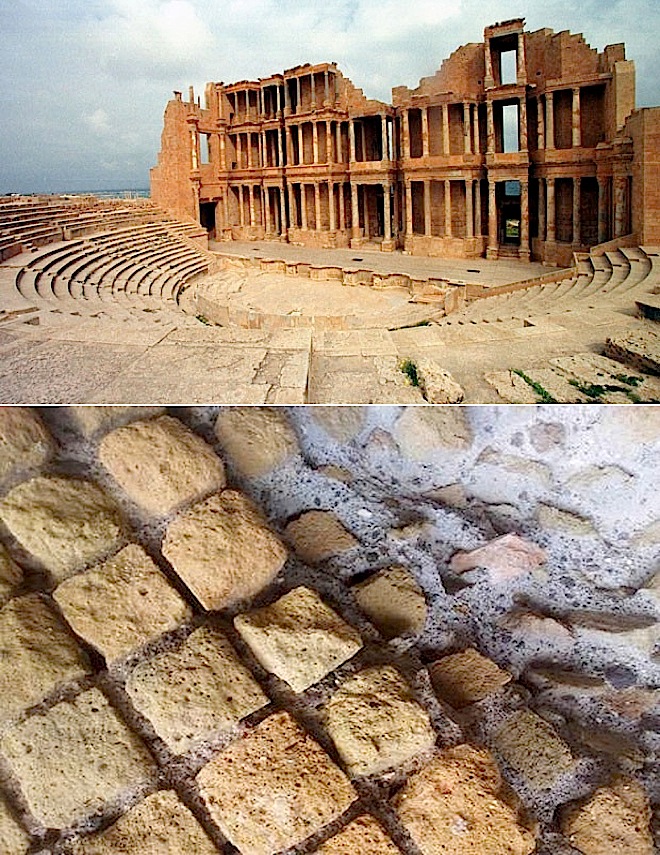
High performance Roman concrete displays the same chemical makeup of calcium-aluminum-silicate-hydrate compounds as artificial geopolymer limestones of the Great Pyramid, situated in present-day Giza, Egypt. The great preservation of the Giza pyramids also witnessed at many Roman amphitheaters attests to their material and structural excellence, having withstood so many centuries in regions of high tectonic activity (above). Built by Emperor Vespasian and his heir Titus from 70-80AD, the Colosseum represents the zenith of Roman geopolymer concrete engineering in a grand elliptical format (below).
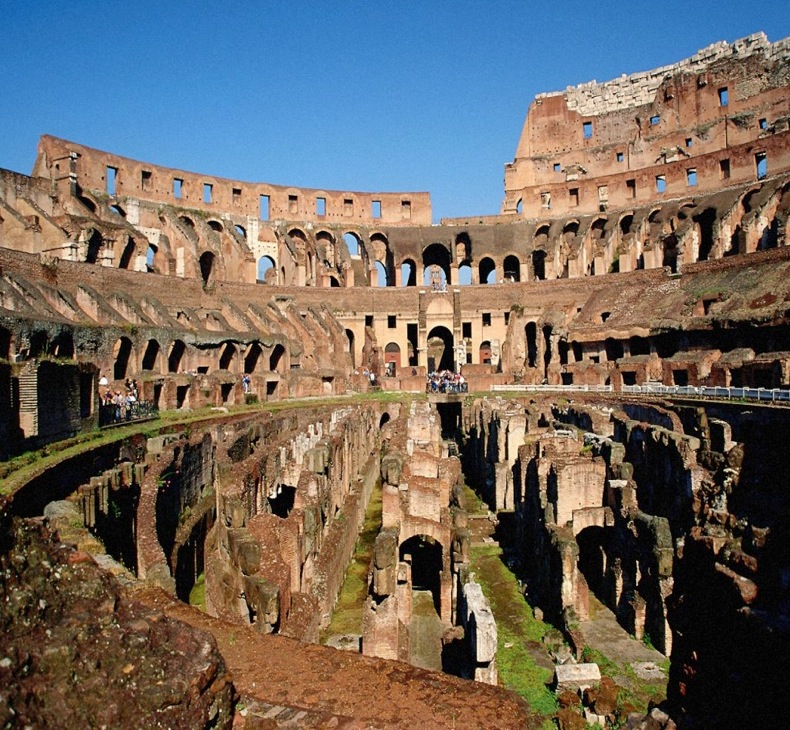
The extraordinary acoustical engineering of Greek and Roman amphitheaters was achieved by sharp geometric conformation of theatrical spaces to concentric circles enhanced by tuned concave limestone seating arrays and strategic placement of dozens of large bronze urns that acted as resonant amplifiers:
The ancient theatre of Lyttus in Crete (Candia)... contained three rows of 13 acoustic vases in each, known also as "echea". According to Vitruvius, "echea", which are actually Helmholtz resonators, were placed in ancient Greek and Roman theatres in order to improve their acoustic performance.
Advanced acoustical engineering and geopolymer chemistry enabled architectural monuments honoring the High Priest of Jupiter: founder of Roman cities by civil application of high sciences, upheld as Divus Julius. The Atlantean Paleo-Sanskrit civilization deified Jupiter for thunderous infrasound transduced by pyramids, as understood by ancient Stoic philosophers and later transmitted to Posidonius, teacher of Julius Caesar. Psychoacoustic knowledge preserved in the Bible and Essene Gospels has been directly linked to Caesar in an insightful hypothesis first examined by Bauer (1843), later by Stauffer (1952), and more recently by an Italian author who compares the Biblical Jesus with the life history of Julius Caesar.
In his book 'Jesus Was Caesar' (2005), Francesco Carotta addresses the essential question: "Is Jesus the historical figure of Divus Julius, the God to which Julius Caesar was elevated?" Decades of liturgical research by Carotta succinctly confirms this hypothesis by detailing name and place substitutions in the Bible that directly correspond to the life, death and apotheosis of Caesar, revealing the Julian origin of Christianity. Carotta identifies the Christian cross as a Roman tropaeum (below); a wooden cross displaying the armor of vanquished leaders --also used to display a wax copy of Caesar's corpse.
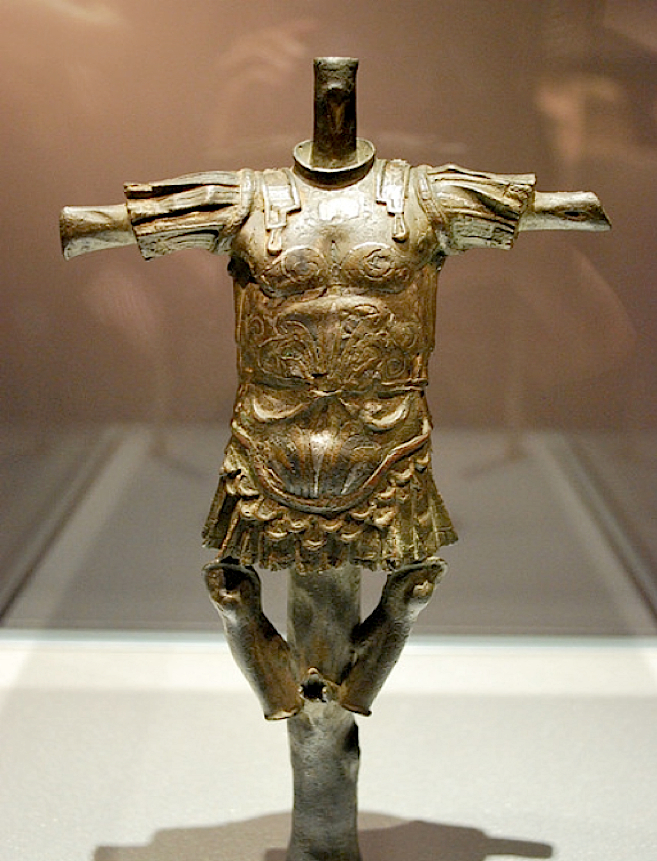
Historical circumstances inspiring the Biblical narrative of the Resurrection of Christ find root in images of Caesar's resurrection on the funeral bier before cremation below his full-figure wax effigy displayed on the tropaeum, as partly depicted on later denarii by L. Buca (below). The crowned profile portrait head of Venus Genetrix stamped on the reverse side appeared on many coins commemorating the founding Julian line of Iulus, grandson of Venus, a motif that transformed into Biblical imagery of the Madonna.
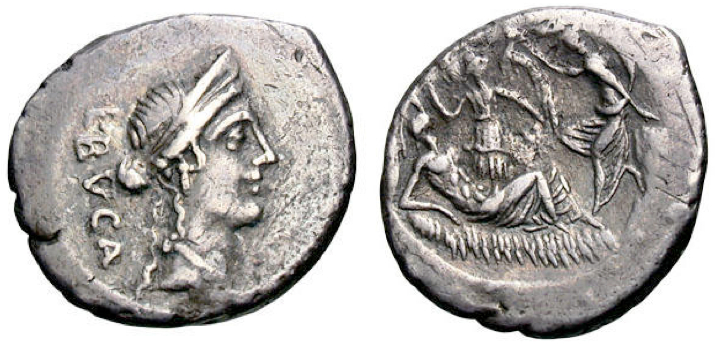
Carotta's thorough comparison of places, names and event timelines in the lives of Julius and Jesus painstakingly establishes Julian precedents for Biblical accounts in succinct order. Jesus' miracle of walking on the sea is based on Julius' attempted crossing of a stormy Adriatic, saying "Do not fear, you sail Caesar in your boat, and Caesar's luck sails with us!" Carotta highlights many compelling parallels:
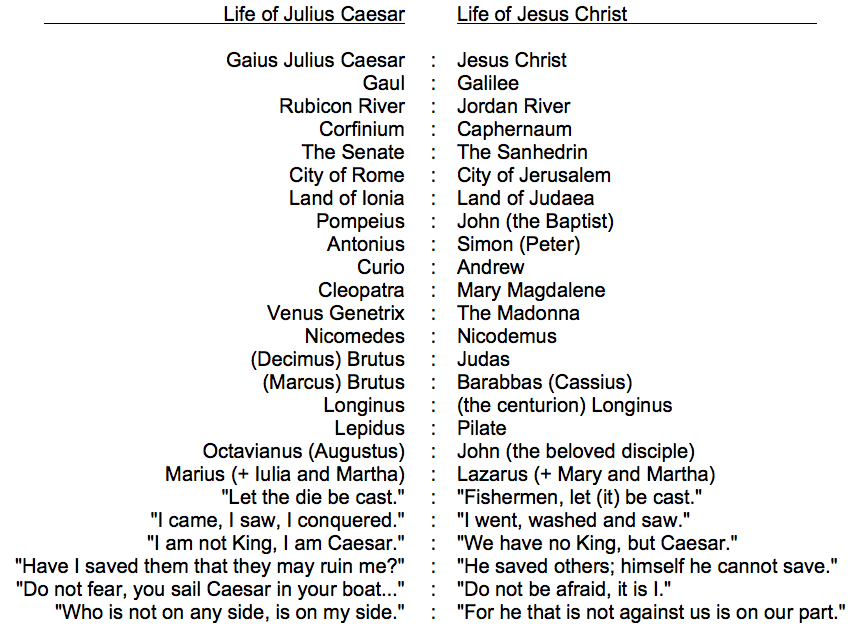
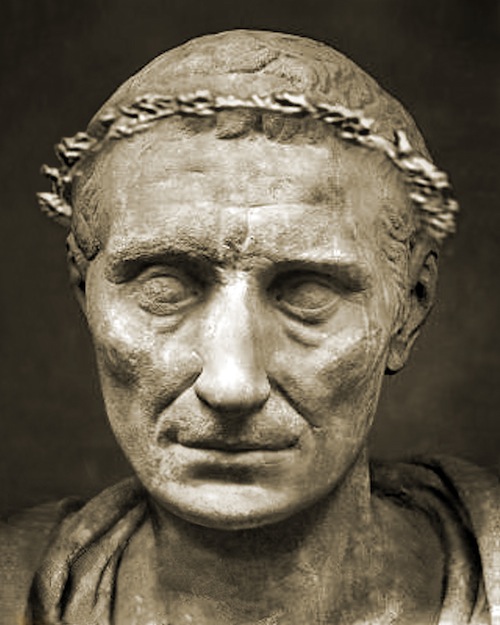
The resemblance between Caesar's grass wreath and Jesus' crown of thorns may be a coincidence... But the fact that a statue of Caesar may have had the appearance of a pietŕ... [is evident, with] the inscription on the base --Parenti Optime Merito, 'to the most meritorious parent'-- reads like a replica of that found on the temple of Jupiter --(D)iovi(Patri) Optimo Maximo, 'to the Father God (Jupiter) best and greatest' and which is still to be seen on our churches in the abbreviated form DOM (Deo Optimo Maximo), 'to the best, highest God'.
The hollow face of suffering presented by the 'Pietŕ of Caesar', at the Torlonia Museum (without a wreath), displays a lowered head position and sunken, baggy eyes revised to evoke pity and revenge for Caesar's murder (above). In contrast, the only sculptural representation made during the later years of Caesar's life, excavated in Tusculum, displays a shrewd, calculating gaze, holding his chin up with pride for the many military campaigns, victories and civil accomplishments (below). The slight smile gracing Caesar's face reflects his notorious clemency. All emotive charisma of the living Caesar was removed from the Pietŕ image, while Carotta shows how the inscription became mistranslated into later Greek texts as 'chręstos' or 'christos':
It should be observed that linguistically, parens, 'parent' or 'father' and creator, in the sense of 'founder' especially a 'founder of cities', is called ktistęs by the Greeks, while optimus is usually rendered aristos --both translations are well documented, additionally on Roman imperial coins in the East. Conversely, the words meritus, 'meritorious', as well as bonus, 'good' --whereby optimus, 'the best', is an intensification-- can in this sense be appropriately translated by the Greek word chręstos, a word whose classical pronunciation was already becoming replaced by the late Hellenistic christos, which is still used today. Hence, on the base of the first cult-statue of the new god Caesar, the Greek speaking people read that the divine founder of the empire was optime meritus which meant for them chręstos, respectively christos. This would not surprise them, because they were used to addressing their deceased on epitaphs with chręste, 'good'. For Caesar the word fit perfectly, because he was 'good': proven by his much acclaimed clemency. Indeed, the defeated Pompeius had called upon his followers to reconcile themselves to the stronger Caesar because he would be well-disposed and 'good': chręstos.
Parens, optimus, meritus --ktistęs, aristos, chręstos. Three words, each of them (the last one is very telling) resembling in appearance and pronunciation that of another word, christos, 'anointed', which later emerged as the title of Jesus. The possibility of confusing chręstos with christos was so easy and natural, that the spelling with an 'ę' instead of an 'i' is still to be found in some writings of the Classics (for example Tacitus' chrestiani which was changed to christiani, or Suetonius' chresto as well, interpreted by some as Christus) and also in the New Testament in various places.
But this happened later, in another context. For the moment, nobody would have gained anything by a possible confusion of chręstos, 'meritorious', with christos, 'anointed', nor would they have taken offence, because both high priests and kings were anointed, and Caesar had been both at once --the first in very fact, the second by reputation.
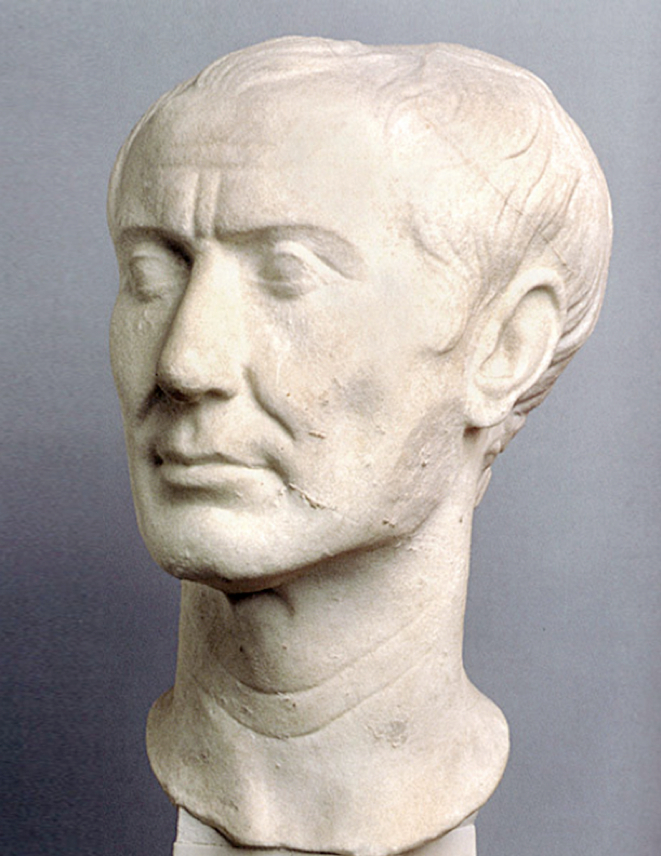
The Tusculum Head is a highly realistic life-size portrait of Julius Caesar (above) thought to have been created in 46BC, less than two years before Caesar's assassination in 44BC, at the age of 55. The subtle facial expression and very natural forms of the long neck have led to speculation that the stonework was carved as a copy of a wax life-cast of Caesar's face. The actual process may have been simpler still.
On display at the Museum of Antiquities, in Turin, the Tusculum Head of Caesar is composed of Luni marble, obtained from the Liguria region of northern Italy, just 5km north of Carrara, famous for its high quality marble quarries. This representation stands apart from all other portraits of the Roman cult hero, being the only representation to display Caesar's partial baldness, and even the irregularities of his skull:
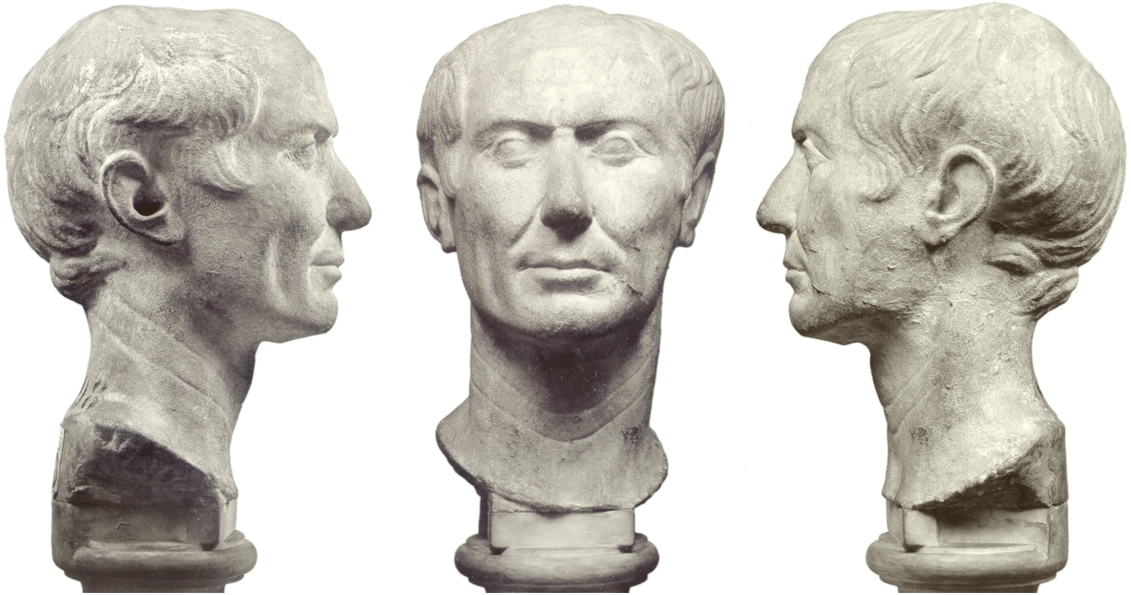
Now famous, a marble bust from Tusculum has been identified as that of Caesar by the typical saddle of the crown accentuated by the bold forehead, the angular jawline, the 'vulturine' neck, and --last but not least-- by the ironic lines of the mouth. Here is the same vision and will, but the clementia is more concealed by a stronger sense of irony. One can see the ruler of the world advancing, and sense there is a claiming of ownership, and an inaccessibility. Before us is the Caesar of veni vidi vici.
The confidence and intense focus of the expression captured in the Tusculum Head reveals a hidden agenda behind the subversive weakness expressed in the Torlonia Head that Carotta identifies as Caesar's Pietŕ. The sharp contrast between a man who "conquered the known world in sandals" and a "christened and crucified Savior in sandals" finds its very first expression in the Pietŕ's morose features.
Subtle manipulations of Caesar's facial expression reveal the Tusculum Head as the original, definitive portrait of Julius Caesar, yet presents distinct surface flaws and fine discontinuities in the pedestal forms not witnessed on any of the later representations produced in stone. Treatment of the base bears evidence of a stone pedestal and a block of wood with central shaft supporting the life-cast wax head.
Retouching of the nose, eyes, eyebrows and hair was accomplished after the raw wax copy was poured, while smooth areas of skin were left largely unaltered --to great effect. Perhaps such minor defects were not removed from the final product to preserve the delicate slipcoat layer? Telltale casting imperfections preserved on the Tusculum Head deny the possibility this stonework was carved from a block of stone in a conventional manner, instead directly implicate a 'lost wax' method involving wax burn-out from a plaster mold before hot pouring a fine geopolymer powder mix of marble, clay, lime and water.
The Tusculum Head was clearly used as the model for coins struck during the final year of Caesar's life, bearing details of the original wax portrait head preserved in geopolymer marble (below). Like the later sculptures produced after the death of Caesar, profile portraits on coins were similarly reduced to idealized images that retain little semblance to his actual countenance. However, design standards adhered to by Roman minters have been overlooked, like basic symbols presented on the $1 bill today.
The circular coins were always outlined with the same specific circular pattern of adjoined semi-circles or circles conforming to the geometric structure of standing waves as they encircle the sphere of the Earth. Roman coin designs confirm Roman psychoacoustic engineers were aware of the spherical shape of the planet and focal patterns of planetary resonance now identified as infrasound standing waves.
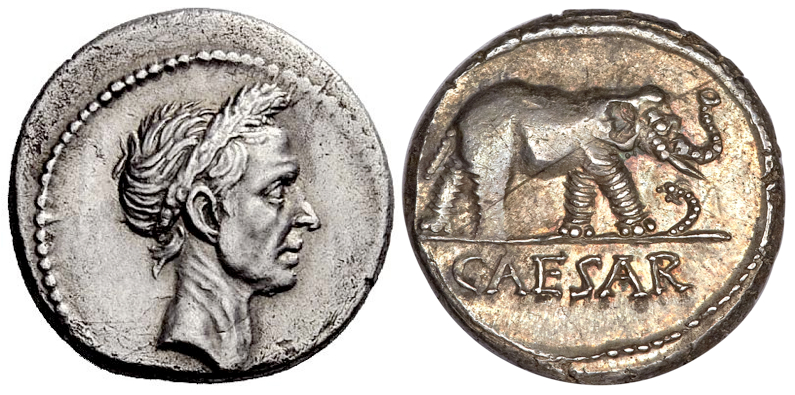
An ancient technological hero of the people akin to the world famous modern inventor Nikola Tesla, Julius Caesar was renowned for his highly advanced implementation of especially geopositioned sites for geopolymer construction of piezoelectric temples for infrasound resonance technologies that had electrified and illuminated domestic life in Roman cities. This provides the most convincing explanation as to the origin of Caesar's title of 'High Priest of Jupiter' and associated elephant symbolism (above).
The Paleo-Sanskrit language and nonlinear physics underlying the psychoacoustic associations of Indra, the deified planet Jupiter, reveal the deeper Paleolithic origin of the elephant symbol as a hieroglyph, according to the Schildmann Decipherment. Jupiter was signified by several sacred glyphs still in use today in diverse parts of the world, including the square, the elephant, the whale and the seven-pointed candelabra configuration later adopted by Judaic traditions as the Menorah. For Paleo-Sanskrit authors, Jupiter's sacred number was 7 --encoding its 399-day synodic year as 7 + 72 + 73 (7 + 49 + 343 = 399).
The oldest Paleolithic texts yet identified uphold Jupiter's vital influence on resonant limestone cavesites, as preserved in remarkable form on the painted geopolymer walls of Lascaux and Chauvet Caves in present-day France. Subtitling of a Megaloceros airbrushed in black charcoal at Lascaux Cave reads: Indra * * * * * * , meaning "Jupiter, the one, the one..." A similar phrase airbrushed in red ochre paint deep within Chauvet Cave reads: adhi ra * * * * * * , or "Delivering granting of the one, the one..."
The deeper Atlantean roots of highly advanced psychoacoustic knowledge demonstrated by the great achievements of Roman monumental construction were preserved with symbolic forms intact. Roman application of such advanced physics knowledge accounts for the great respect held for Julius Caesar throughout the Empire, supporting the identification of Caesar as the founder of modern civilization.
Ancient Atlantean metalworks found in North American caves in both Mexico and the US further confirm the Paleolithic origin of the ancient elephant and palm tree symbols found on coins commemorating Julius Caesar --works produced over ten thousand years after the collapse of the advanced Paleo-Sanskrit motherculture due to a multitude of cometary impacts in the Atlantic region 12,890 years ago.
Among several gold plates found by Jose Padilla at a burial site in Guerrero, Mexico in 1960 is a disc displaying the same elephant icon in profile, with its trunk raised in vocalization, vibrating the ground below the elephant's feet representing long distance infrasound communication (below). The droplet shape of the gold sheet references sacred Vedic water containing colloidal gold, called Soma:
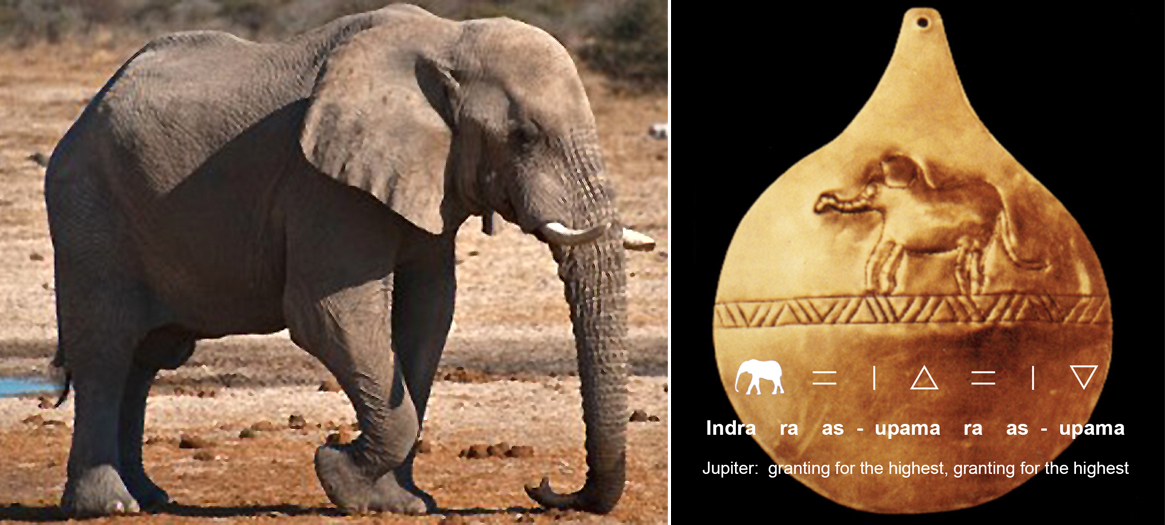
Surprisingly, the disc depicts an elephant --an animal not native to Central America, but to Africa and Asia-- in a standing position that is truly specific in its implications. Modern biology has only recently rediscovered the elephant's use of infrasound communication over vast distances. The ultra low vocalizations of these large pachyderms can carry around the globe coherently, and are used to send messages between herds across the great continent of Africa. Biologists have only recently filmed elephants standing with a front foot touching the ground only by the sensitive toenails, just as positioned on the Guerrero gold plate! The ancient Sanskrit artists of Oaxaca have depicted the inaudible infrasound signal as zigzag waveforms traveling through the ground to be received through the elephant's toenails [as well as through the trunk when laid on the ground].
In the Paleo-Sanskrit language, the elephant hieroglyph symbolized Indra, the deified planet Jupiter that resonates deep infrasonic standing waves focused by the precisely geopositioned worldwide network of monumental pyramids and megaliths. Glyphs rendered below the elephant give the impression of ground vibrations, offering the full repeating hieroglyphic phrase: Indra ra as-upama ra as-upama ra as-upama , meaning "Jupiter: granting for the highest, granting for the highest, granting for the highest..." (above).
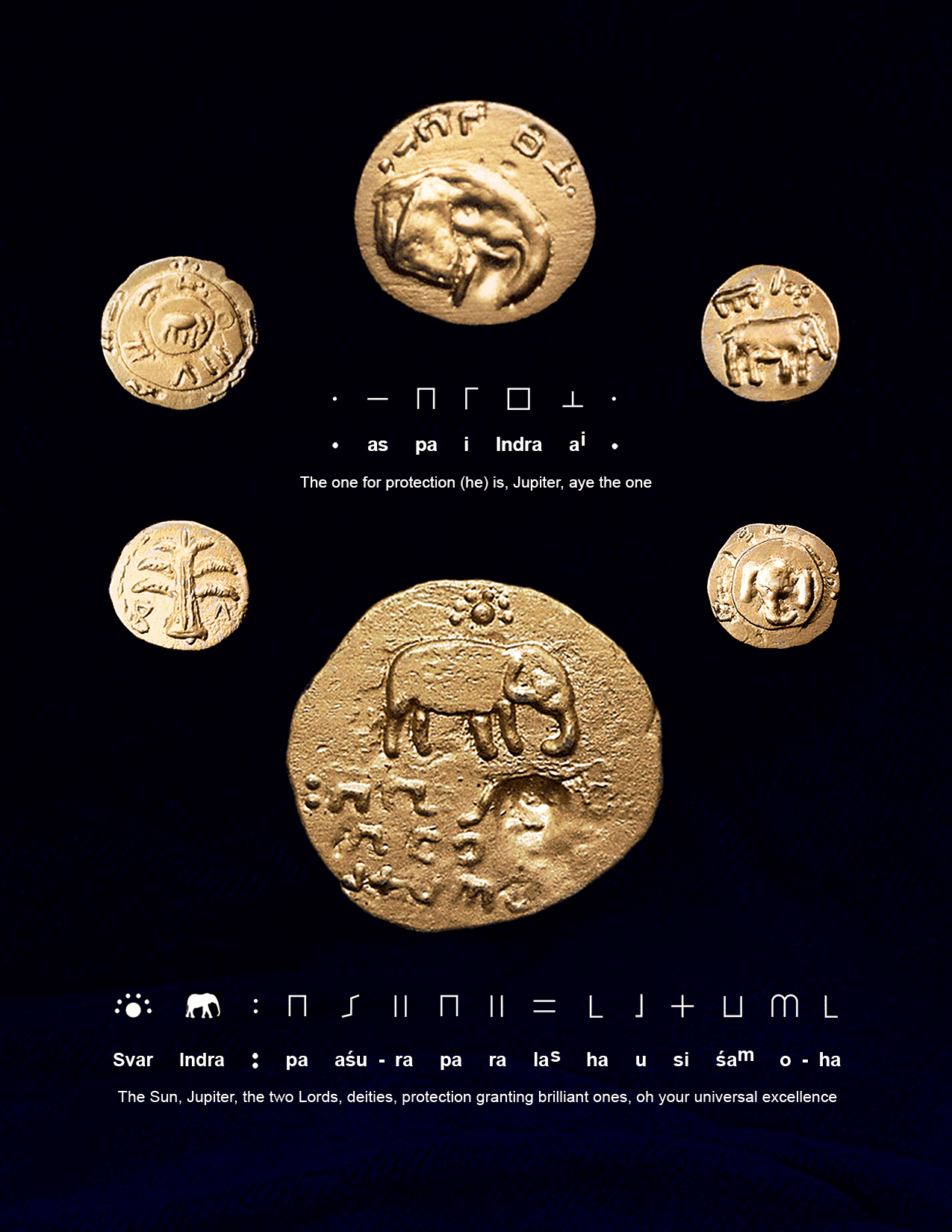
Similar Paleolithic artifacts with comparable statements praising beneficial infrasonic influences from Jupiter have also been retrieved in the US, from the Illinois Cave archive (above). One gold coin presenting the profile portrait head of an elephant is subtitled with Paleo-Sanskrit glyphs that read as: * as pa i Indra ai * , meaning "The one for protection (he) is, Jupiter, aye, the one".
The elephant glyph also appears with a glyph for the Sun, with the six innermost planets of the solar system represented on a circular gold plate, reading: Svar Indra : pa asura pa ra las ha u si sam oha, meaning "The Sun, Jupiter, the two Lords, deities, protection granting brilliant ones, oh your universal excellence" (above). The great abundance of Paleo-Sanskrit artifacts bearing the elephant glyph for Jupiter leaves no doubt that Julius Caesar was High Priest of Jupiter, signified by the elephant, for his tremendous knowledge of infrasound standing waves, as rediscovered by Nikola Tesla in 1899.
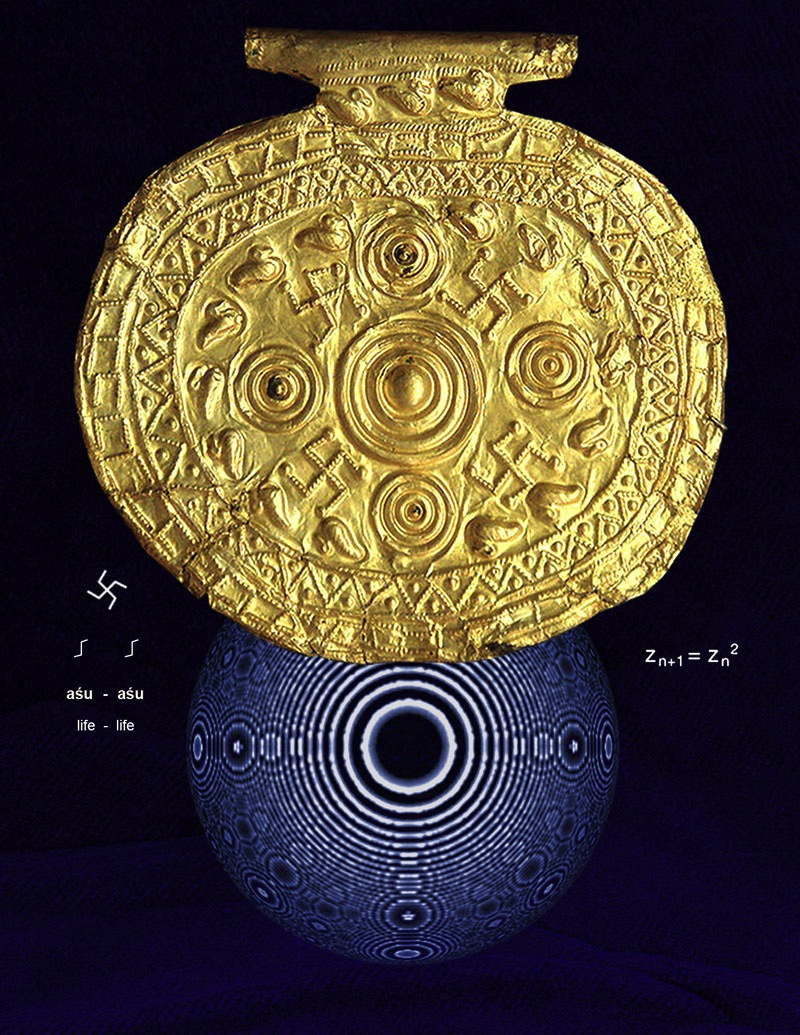
Before his murder by Nazi agents in early 1943, Tesla had secretly developed monopulse radar designs using the quantum quadratic function for nonlinear standing waves: [ zn+1 = zn2 ]. The quadratic standing wave function can also be used to map Earth's sphere, revealing resonant nodal geopositions enabling efficient transduction of planetary resonance for wireless power; advanced knowledge that had also been utilized by Julius Caesar and exactly rendered in Etruscan goldwork with swastika glyphs (above).

Roman temple sites confirm great circle pyramid alignments were also observed by Caesar: 'Founder of Cities' for wireless reception of infrasound. The ancient Roman city of Luna (44.06°N 10.00°E) is 1,511 miles from the apex of the Great Pyramid at Giza, a distance corresponding to 6.0% of Earth's mean circumference of 24,892 miles. This resonant geoposition is located precisely along the 44th N latitude, while its 6.0% great circle distance to Giza corresponds closely to 1/16 of Earth's mean circumference.
The Colosseum in Rome, Italy (41.89°N 12.49°E) is located 1,324 miles from the Great Pyramid, comprising 5.3% of Earth's mean circumference. This resonant distance measurement approximates half the values of Fibonacci #131 in terms of percent of Earth's mean circumference and Fibonacci #353 in terms of miles (5.26% and 1,309 miles would accord to precisely half the F# values).
Continue to The Llanganates Complex
Return to Baltic Sea Monument
From the book Magnetic Center
Copyright 2014-2015 Alexander Putney